Special Considerations in Pediatric Cardiac Arrest
Some causes of cardiac arrest require specific interventions. These special causes include:
- Trauma
- Drowning
- Anaphylaxis
- Poisoning
- Congenital heart disease
- Pulmonary hypertension
Cardiac Arrest Due to Trauma
The survival of patients with out-of-hospital cardiac arrest secondary to trauma is very low. Delays in treating penetration injuries and transferring the patient to a trauma center negatively affect outcomes. Improper administration of volume expanders can be detrimental to the pediatric trauma patient.
Causes of cardiac arrest in children following trauma:
- Hypoxia from respiratory arrest, airway obstruction, or tracheobronchial injury
- Injury to vital organs such as the heart, aorta, and pulmonary arteries
- Severe brain injury with concomitant cardiovascular collapse
- Upper cervical spinal injury causing cord resection with respiratory arrest
- Diminished cardiac output or PEA from tension pneumothorax, cardiac tamponade, or massive hemorrhage
In trauma, the team still follows the BLS and PALS algorithms. When resuscitating the pediatric trauma patient, the team must also:
- Anticipate airway obstruction from bony or dental fragments, blood, and other debris.
- Control external bleeding sites to prevent massive blood loss.
- Transfer the patient to a suitable institution with a trauma center for pediatric patients as soon as possible.
- Establish an IV or IO line as quickly as possible for volume replacement.
2020 AHA Update — For hemorrhagic shock following blood loss from trauma, the provider should consider administering blood products instead of crystalloid IV fluids.
This table gives the concise management of a pediatric trauma patient.
Management of Cardiac Arrest Secondary to Trauma
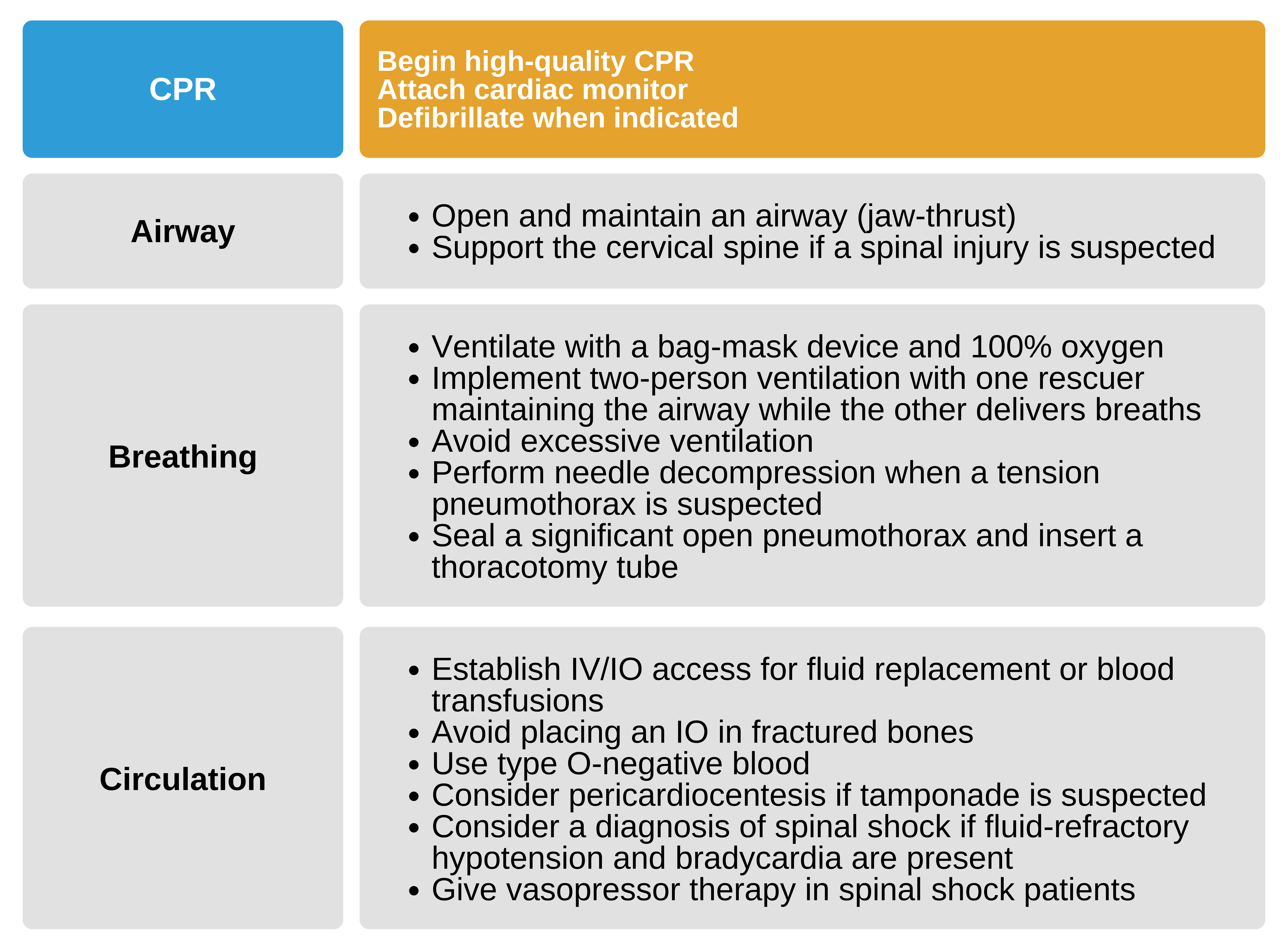
Management of cardiac arrest secondary to trauma.
Cardiac Arrest Secondary to Drowning
High-quality CPR is the most critical intervention for patients following drowning. High-quality CPR begins with chest compressions. Chest compressions should be initiated as soon as the child is moved to a safe location. Rescuers should try to place the child supine on a flat surface.
There are no special modifications to the BLS sequence in the case of drowning. Spinal injuries and hypothermia must be considered as contributory factors to cardiac arrest following drowning. Hypothermia may be the primary cause of cardiac arrest if the child is rescued from icy waters.
The hypothermic patient is not considered dead until they are warm and dead. Patients are known to have survived after exposure to freezing temperatures for as long as 40 minutes. Therefore, resuscitative efforts must continue until the child’s core temperature reaches at least 30°C before a decision is made to withdraw CPR.
The team should consider extracorporeal circulation (if available) to provide effective and efficient warming. These patients should be transferred to an institution that is experienced and well-equipped in treating drowning patients and patients with hypothermia.
Management of Cardiac Arrest Secondary to Drowning
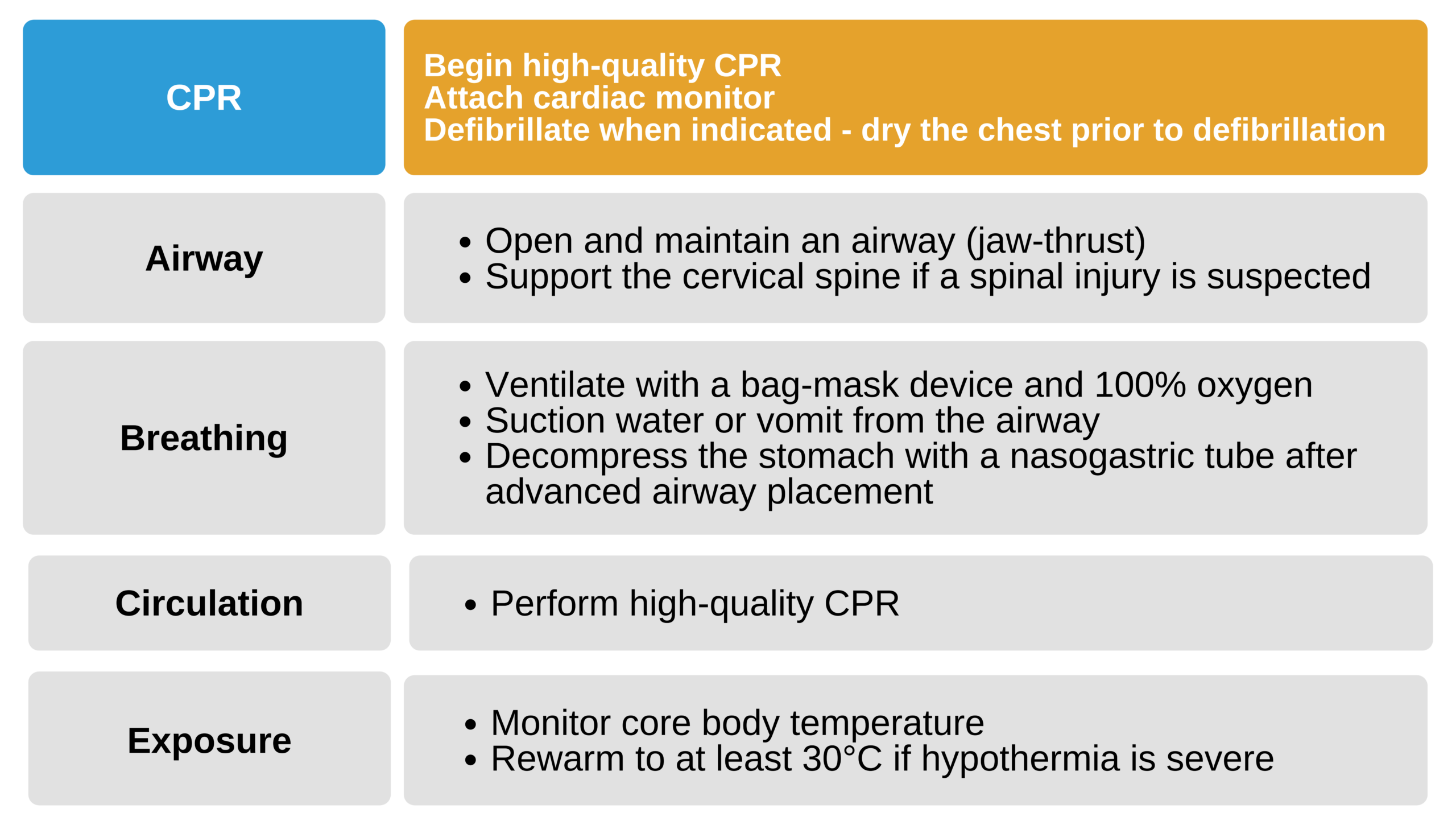
Management of cardiac arrest secondary to drowning.
Related Video – Spotting a Drowning Victim
Cardiac Arrest Secondary to Anaphylaxis
Anaphylaxis causes significant vasodilation and edema. Edema of the soft tissues throughout the airway can cause airway obstruction. Profound vasodilation causes substantial hypovolemia. The result is impaired oxygen delivery.

Swollen Lips Due to Allergic Reaction
If anaphylaxis causes cardiac arrest, the provider prioritizes high-quality CPR with attention to maintaining a patent airway and fluid therapy. Epinephrine is the drug of choice for treating anaphylaxis. The goal of high-quality CPR is to maintain adequate oxygen delivery until the anaphylactic reaction resolves.
Steroid therapy can be of value in the management of anaphylaxis after the resolution of cardiac arrest. After ROSC, the team should administer methylprednisolone at a dose of 1–2 mg/kg IV or IO as part of post-cardiac arrest care.
Management of Cardiac Arrest Secondary to Anaphylaxis
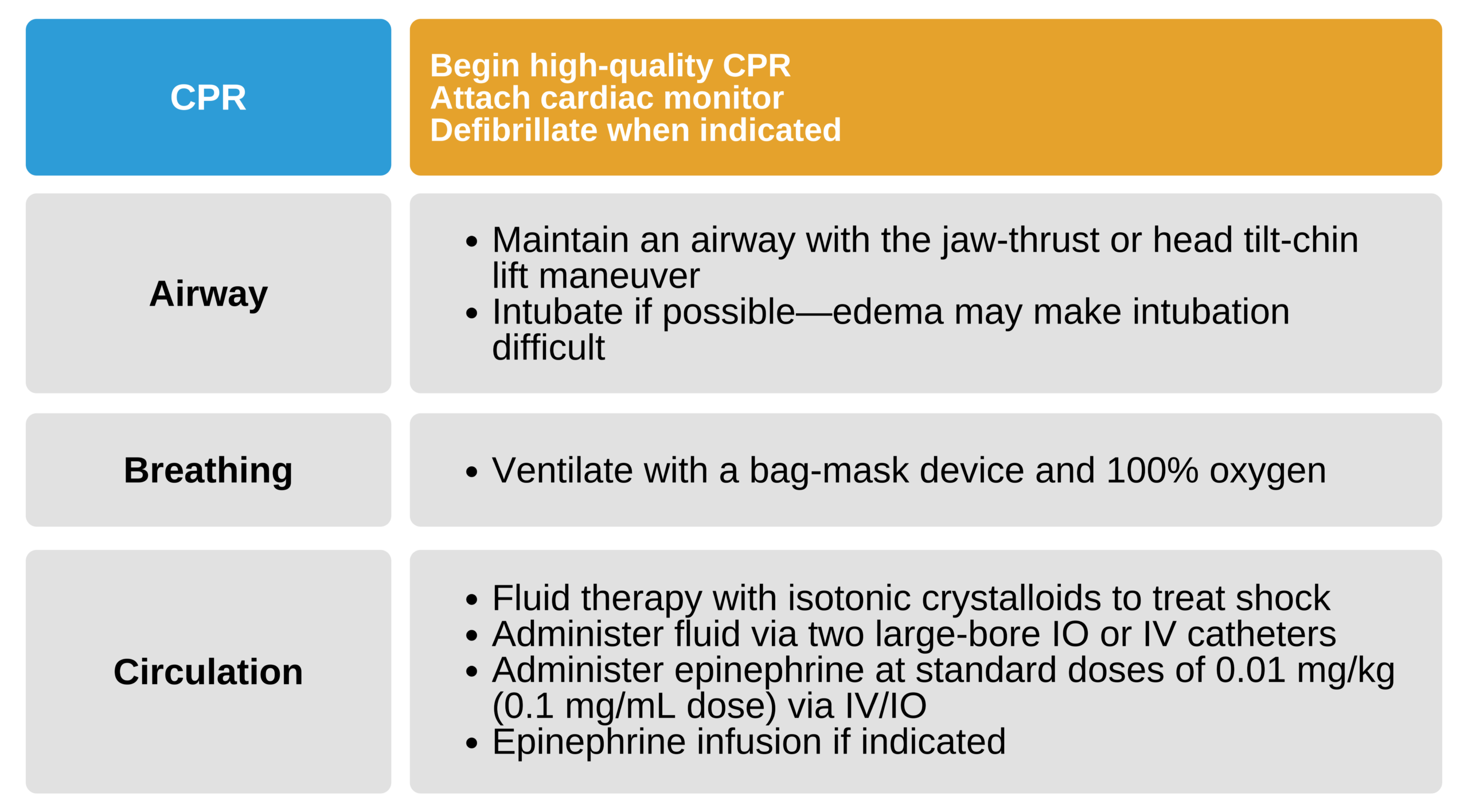
Management of cardiac arrest secondary to anaphylaxis.
Cardiac Arrest Secondary to Poisoning
Poisoning or drug overdose can lead to respiratory depression and arrest, cardiac toxicity, arrhythmias, hypotension, and airway obstruction that ultimately cause cardiac arrest. The function of the myocardium may be affected until the poison is metabolized and excreted or antidotes reverse the effects. The time for this process varies depending on the half-life of the drug or toxin.
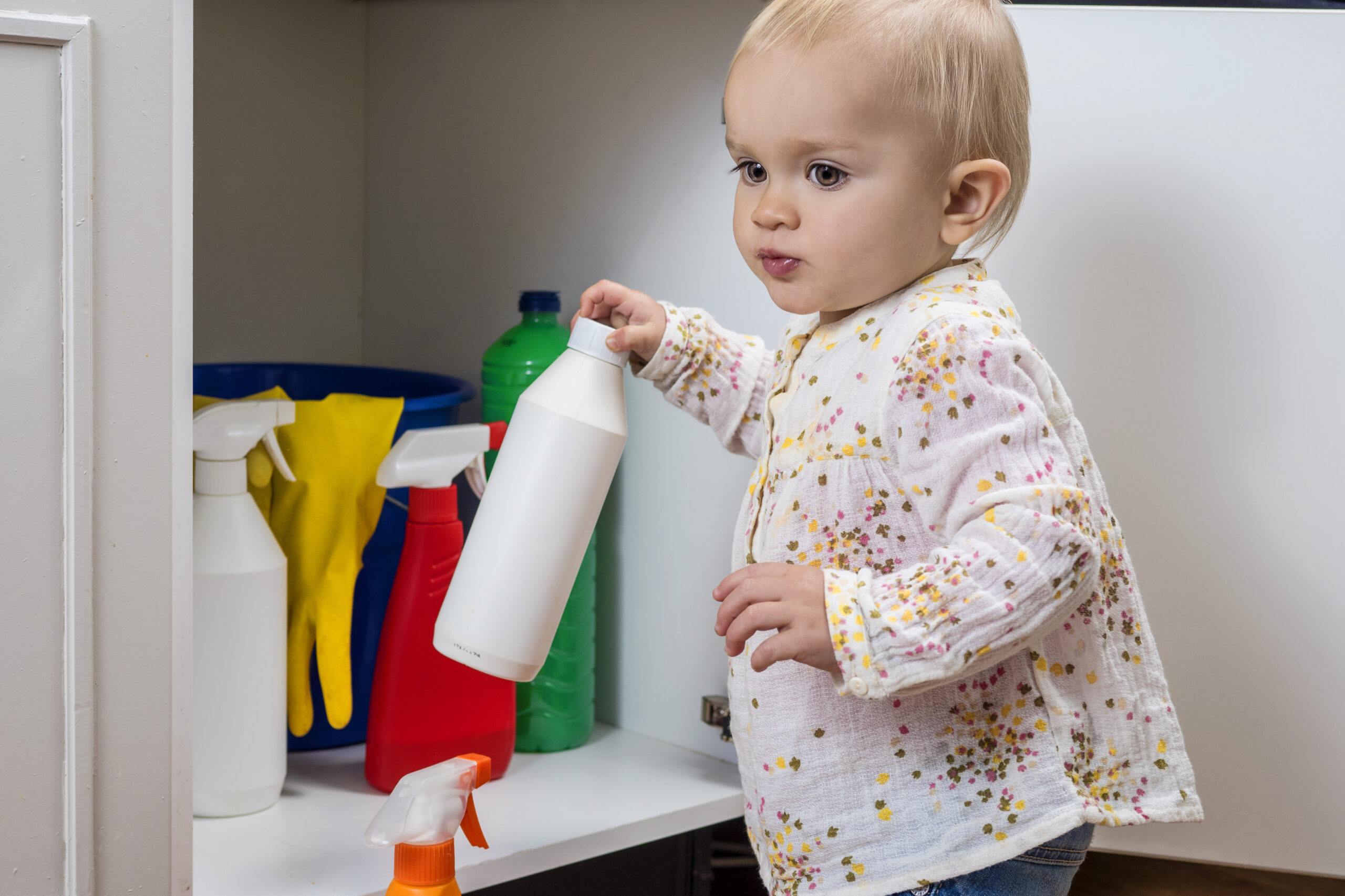
Common household supplies are a potential source of poisoning.
If a patient develops cardiac arrest secondary to poisoning, it is critical to identify the toxic agent to determine the appropriate interventions. The provider should seek immediate consultation with a toxicologist or an institution with a poison control center.
The PALS cardiac arrest algorithm should be followed to manage cardiac arrest in these cases.
Cardiac Arrest Secondary to Congenital Heart Disease22
Pediatric patients with congenital heart disease (CHD) may go into cardiac arrest if the condition affects the ventricles. Tricuspid atresia, pulmonary atresia, and hypoplastic left heart syndrome are examples of congenital heart disease that affects the ventricles.
If these children go into cardiac arrest, the team must:
- Implement the PALS cardiac arrest algorithm.
- Consider heparin administration if the defect affects the aortopulmonary or right ventricular-pulmonary artery shunt and patency is a concern.
- Titrate oxygen supplementation to achieve an appropriate oxygen saturation or optimal pulmonary-to-systemic blood flow ratio during postresuscitation care.
- Consider permissive hypoventilation strategies or negative-pressure ventilation to improve cardiac output in these patients.
Pediatric patients with single-ventricle CHD have altered pulmonary blood flow that will not reflect cardiac output because other factors may influence it and make ETCO2 readings unreliable.
Cardiac Arrest Secondary to Pulmonary Hypertension23
In pulmonary hypertension, the pulmonary arteries have increased resistance to blood flow, which causes a decrease in cardiac output because only a small volume of blood enters the ventricles during diastole. When resuscitating patients in cardiac arrest secondary to pulmonary hypertension, the providers still follow the PALS Cardiac Arrest algorithm.
Elevated PaCO2 levels and the resultant acidosis during cardiac arrest aggravate the underlying pulmonary hypertension that precipitated the crisis. The clinician must pay careful attention to providing adequate ventilation during resuscitation and may choose to target mild hyperventilation to offset the rising PaCO2.
A bolus of an isotonic crystalloid solution such as normal saline solution may support cardiac output by maintaining ventricular preload. Nitric oxide or prostacyclin by inhalation may also be administered to help reduce pulmonary vascular resistance. If inhaled nitric oxide or prostacyclin were initiated prior to cardiac arrest, the patient should continue receiving those therapies during CPR.
Extracorporeal CPR
Extracorporeal CPR (ECPR) may be an option if the child has an in-hospital arrest at an institution that is experienced and fully equipped with existing extracorporeal membrane oxygenation protocols. Some studies show improved survival to hospital discharge by using this procedure in select cases such as pediatric patients with underlying cardiac disease.23
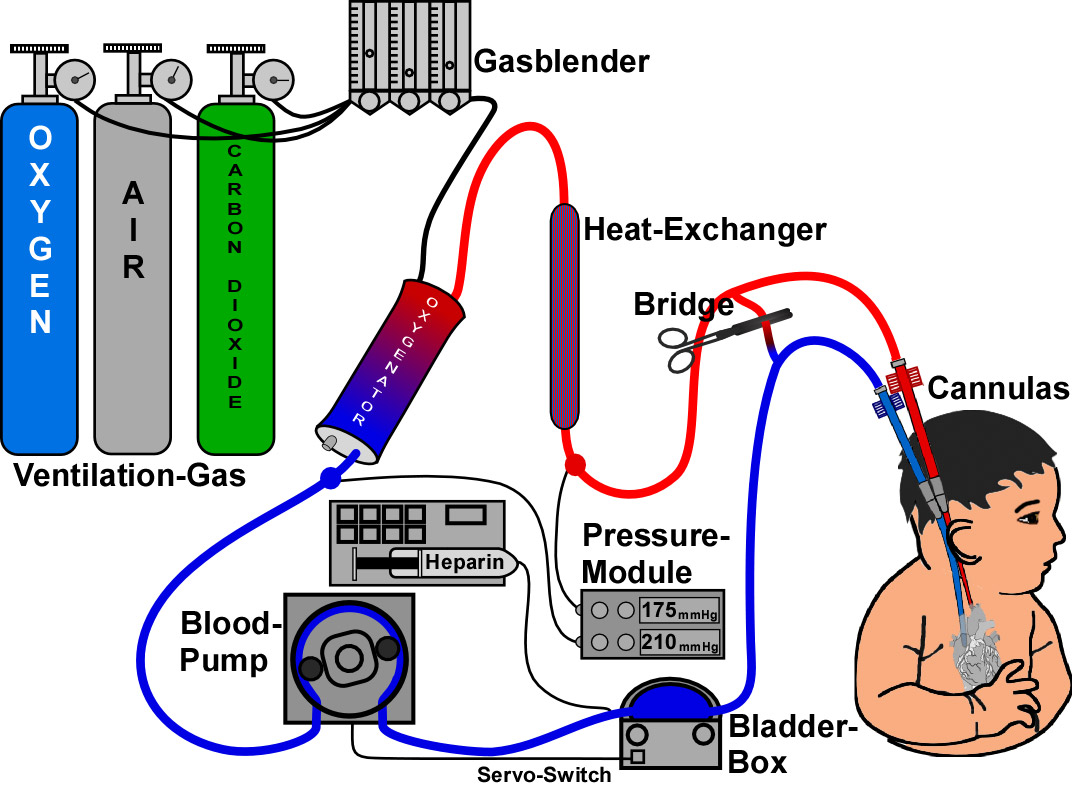
Extracorporeal Membrane Oxygenation
Related Video – ECMO Explained – What is It and How It Works
22 Marino BS, Tabbutt S, MacLaren G, et al. Cardiopulmonary resuscitation in infants and children with cardiac disease: a scientific statement from the American Heart Association. Circulation. 2018;137(22):e691–e782.
https://www.ahajournals.org/doi/full/10.1161/CIR.0000000000000524
23 Abman SH, Hansmann G, Archer SL, et al. Pediatric pulmonary hypertension: guidelines from the American Heart Association and American Thoracic Society. Circulation. 2015;132(21):2037–2099.
https://www.ahajournals.org/doi/full/10.1161/CIR.0000000000000329
24 Brunetti MA, Gaynor JW, Retzloff LB, et al. Characteristics, risk factors and outcomes of extracorporeal membrane oxygenation use in pediatric cardiac ICUs: a report from the Pediatric Cardiac Critical Care Consortium registry. Pediatr Crit Care Med. 2018;19(6):544–552.